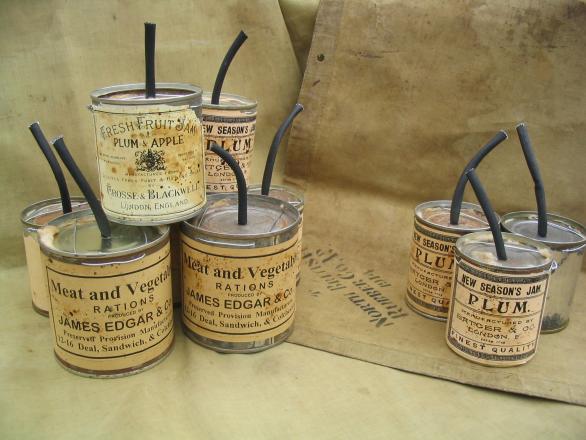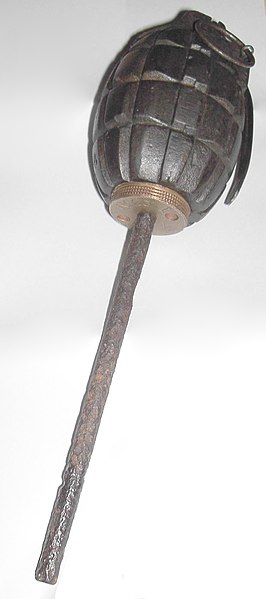Grenades:
Grenades are simply a small, hand held explosive that release shrapnel into the enemy. Normally, the shrapnel is it's own casing, but sometimes there is additional metal inside to make more fragments.

In 1908, modern grenades were invented by the British. They were long-handled impact grenades. As the name implies, the grenades exploded when they hit the ground. The problem is, of course, that can be accidentally set off if they are dropped or jostled.
The British added a pin ad the end of the handle to stick grenades so that they were not so easily set off. Because of the handle, they would fall nose down when thrown, which set off the explosion.This model, the Mark 1 (1914) was unsafe because they were fragile and would explode if they came in contact with anything while being thrown (Imagine your hand hitting the side of the trench while throwing it).

In late 1915, the British issued the No 15 grenade. These were ignited by taking off the covering that protects the fuse and lighting like a match against a matchhead igniter. These were mass produced at rates of more that 200,000 a week. There were problems with these though. The No 15 had a very high explosion which resulted in smaller fragments, which were not as effective. Also, the No 15 were not very weather- resistant. This made them very unpopular.

The British soldiers reverted to making their own "jam tin" grenades which were simply a can filled with dynamite, scrap metal, or stones with a fuse. The fuses had a 1.25 second delay for each inch of fuse.

Probably the most popular and recognized grenade is Mill's bomb or the 'pineapple' grenade. It is named after it's creator, William Mills. The grooves giving it the nickname of 'pineapple' was originally there for grip, but it also helped with fragmentation.
 In fact, these grenades have a danger range farther than the throwing range, so the thrower has to take cover quickly. The Mill's bomb has a strong spring to drive the striker, which is held back by the safety lever, which is held back by the pin. The striker hits the fuse, giving it the delay and detonation.These were so popular, that over 70 million were shipped out to the front to be thrown at the Germans.
In fact, these grenades have a danger range farther than the throwing range, so the thrower has to take cover quickly. The Mill's bomb has a strong spring to drive the striker, which is held back by the safety lever, which is held back by the pin. The striker hits the fuse, giving it the delay and detonation.These were so popular, that over 70 million were shipped out to the front to be thrown at the Germans.Rifle grenades were used in WWI to help the grenades travel farther. The rod launcher had a grenade on the end of a rod which was placed down inside the barrel of a rifle. The soldiers would put their rifles on the ground for leverage. They pulled the pin and shot a blank, sending the grenade high and far. However, the rods damaged the barrels of the rifles and if you took too long or the fuse was too short, the grenade could detonate in your face.

The cup rifle grenade was more popularly used by the French and British. The cup launcher attached to barrel of the rifle and could launch either a standard grenade or a specialized grenade designed for the cup launcher.The safety pin was pulled before the a blank round was shot.

The British and French improved the cup launcher to fire 400 meters compared to the original average of 190 meters. The Germans stopped using the cup launcher in 1916 to attempt to revised it and they didn't start using it again until 1918.
.
The Germans had many types of grenades as well.They had stick grenades that were on a delay, unlike the impact stick grenades that were so dangerous. Impact stick grenades are not unheard of, they were just not as popularly used because of the risk. They also had disc grenades, or 'turtle' grenades.
These grenades are very cool. When thrown, the four pins would be drawn out by centrifugal force. On impact, one or two of the pins would be pressed into the strikers, detonating the grenade. The Germans also had grenades that would explode with hardly any delay so that the enemy had no time to take cover.The egg grenade had a throwing distance of 50 yards, making it popular among the soldiers.
No comments:
Post a Comment